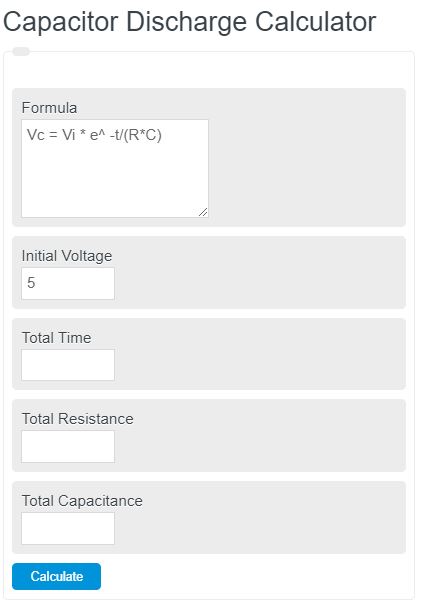Enter the initial voltage, time, resistance, and capacitance into the calculator. The calculator will display the total voltage discharged and remaining.
- Voltage Divider Calculator
- Voltage Calculator
- Impedance Calculator
- Parallel Capacitor Calculator
- Capacitors in Series Calculator
- Cylindrical Capacitor Calculator
Capacitor Discharge Formula
The following formula is used to calculate the discharge of voltage across a capacitor.
Vc = Vi * e^ -t/(R*C)
- Where Vc is the voltage discharged
- Vi is the initial voltage
- t is the total time
- R is the total resistance of the circuit
- C is the total capacitance of the circuit
Capacitor Discharge Definition
Capacitor discharge is the process by which the electrical energy stored in a capacitor is released in a controlled manner.
When a capacitor is charged, it accumulates electric charge on its plates, creating an electric field between them. This stored energy can be discharged when the circuit is completed, allowing the capacitor to release its charge.
Capacitor Discharge Example
How to calculator capacitor discharge
- First, determine the initial voltage
Either measure or calculator the initial voltage entering the capacitor.
- Next, determine the total resistance
Measure the total resistance of the capacitor.
- Next, determine the total capacitance
Measure the total capacitance of the capacitor.
- Finally, calculate the voltage discharge
Using the information from steps 1-3 and the equation above, calculate the total discharged voltage.
FAQ
How does the initial voltage affect the capacitor discharge process?
The initial voltage (Vi) directly influences the amount of energy stored in the capacitor at the beginning of the discharge process. A higher initial voltage means more stored energy, resulting in a longer discharge time under the same resistance (R) and capacitance (C) conditions.
Why is resistance important in the capacitor discharge equation?
Resistance (R) plays a crucial role in the capacitor discharge process because it determines how quickly the stored energy in the capacitor is released. Higher resistance leads to a slower discharge rate, as it limits the flow of current out of the capacitor.
Can the capacitor discharge formula be applied to any type of capacitor?
Yes, the capacitor discharge formula Vc = Vi * e^ -t/(R*C) is generally applicable to any type of capacitor, regardless of its physical construction (e.g., cylindrical, parallel plate). However, the specific values of capacitance (C) and resistance (R) will vary depending on the type and characteristics of the capacitor and the circuit it’s part of.

